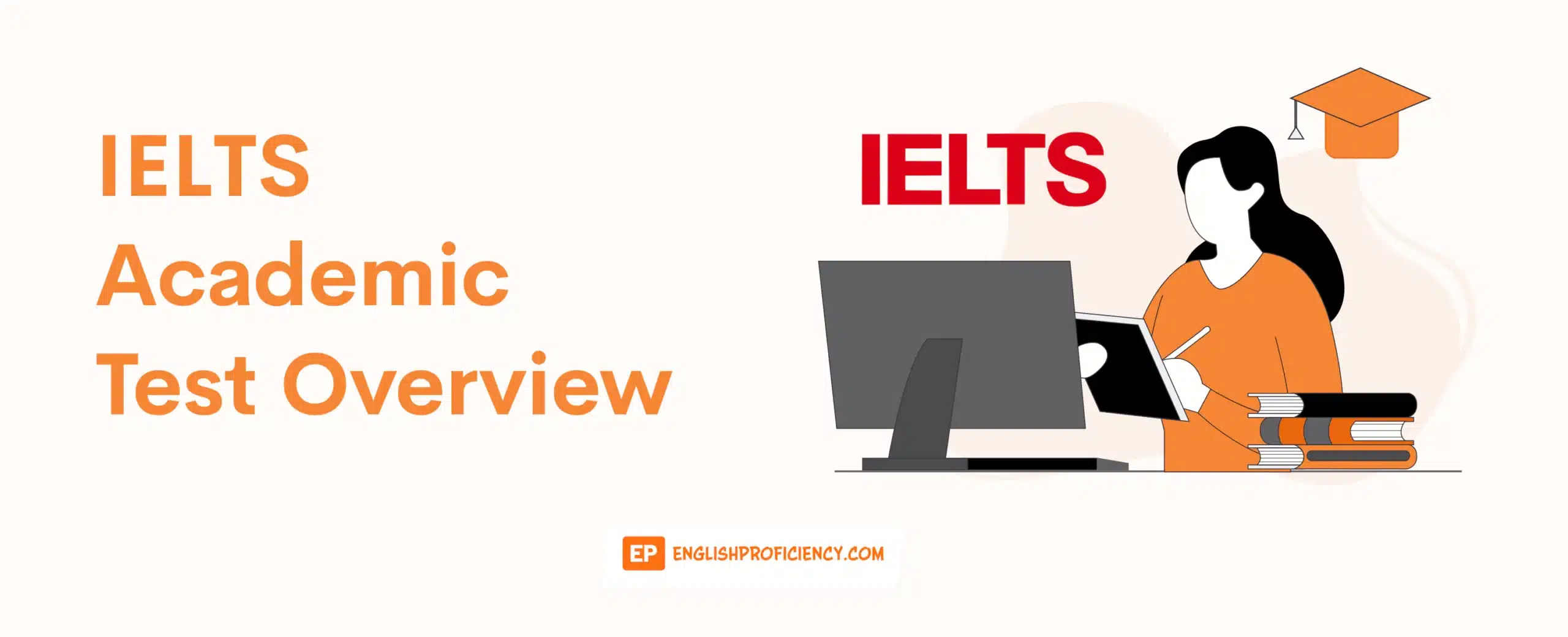The International English Language Testing System (IELTS) is a set of tests designed to assist you if you choose to work, study, or move to a country where English is the primary language. This includes Australia, Canada, New Zealand, the United Kingdom, and the United States. It has four sections: Speaking, Reading, Listening, Writing.
International teams of professionals develop the IELTS test. It undergoes massive research to ensure the test is fair and impartial for all candidates regardless of their nationality, background, gender, lifestyle, or location.
The IELTS Academic is one of the two modules in the IELTS test, the other module being the IELTS General Training. Both modules evaluate your English proficiency in the four fundamental skills: speaking, listening, reading, and writing, but the difficulty level is not the same.
The IELTS Academic Test is intended to assess your readiness to study English or work in an academic setting. If you plan to pursue higher studies or work in Australia, Canada, New Zealand, the United Kingdom, or the United States, the IELTS Academic Test is what you should take.
Contrarily, if you plan to study or train in below degree levels in the countries mentioned earlier, you should take the IELTS General Training Test. It is designed to assess if you are prepared to study or work in a social setting.
The Speaking and Listening sections for the IELTS Academic and the IELTS General Training modules are the same, but the other two tests, Reading and Writing, are different. In this article, we will provide you with every detail to discuss the IELTS Academic Test.
IELTS Academic Test Format
The IELTS Academic Test has four sections:
- Speaking
- Listening
- Reading
- Writing
Since it is intended for higher studies and professional registration, this module is more complex than the IELTS General Training.
Below are the test formats and types of questions that you will encounter in the different sections of the IELTS Academic Test:
1. IELTS Speaking
The IELTS Speaking Test is divided into three parts and is in the form of an informal interview between you and the examiner. You have to take note that the IELTS Speaking Test is held on a different day from the other three tests: Listening, Reading, and Writing.
a) Part 1 or Task 1
The IELTS Speaking Test Part 1 is called ‘The Interview’ and lasts for about 3 to 4 minutes. You will verify your identity first before proceeding to the actual interview. The examiner will ask you for general information about your work, studies, family, hometown, and interests.
Part 1 of the IELTS Speaking Test appraises your skills in expressing your thoughts and beliefs on different topics by answering a series of questions.
Examples:
- What is your favorite subject in school?
- What don’t you like about your job?
- Where do you and your family like to go on holidays?
- What is something interesting about your hometown?
- How do you spend your free time?
b) Part 2 or Task 2
The IELTS Speaking Test Part 2 is called ‘Long Turn’, and takes about 4 to 5 minutes. You will be handed a cue card, or what others call a task card, where you should talk about is written. The other key points that you should include in your speech are also written on the cue card. The most frequent topics in this part of the test include people and places, things you own, your interests, celebrations, and past occurrences.
You have a minute to prepare and another two minutes to talk about the given topic. The examiner controls the time, and you will be notified if your one-minute preparation and two-minute speech are over. The examiner may ask you follow-up questions about your speech.
Part 2 of the IELTS Speaking Test evaluates your competence to speak for a longer period about a specific topic while using proper language and structuring your thoughts logically.
Examples:
Topic/Question:
Describe a time when you have to make a big decision
How to Answer the Question:
- what decision it was
- when you made that decision
- whom you seek for advice
and explain how that decision affected you.
Topic/Question:
Describe a place that brings a lot of fond memories for you
How to Answer the Question:
- what it is
- where it is
- how often you go to this place
and explain how you feel about this place.
c) Part 3 or Task 3
The IELTS Speaking Test Part 3 is called ‘Two-Way Discussion’ and lasts about 4 to 5 minutes. The questions in this part of the test are related to the topics discussed in Parts 1 and 2, but the questions are more difficult because they require you to use your critical thinking skills and your English-speaking skills.
Generally, the questions in this part of the test involve expressing your opinions and judgments, assessing and evaluating certain issues, justifying cause and effect relationships, analyzing the similarities and differences of specific ideas, and speculating and expressing probabilities.
The IELTS Speaking Part 3 evaluates how well you can express ideas logically and abstractly while maintaining fluency and coherence.
Examples:
Topic:
Friends
Sample Questions for the Topic:
- Do you have a lot of friends?
- What makes a good friend?
- What is the difference between how people make friends in the past and these days?
- Why do you think people lose contact with their childhood friends?
- Do you agree that the best form of relationship is friendship?
Topic:
Gender
Sample Questions for the Topic:
- What is the difference between the roles of men and women in society?
- How has the role of men and women changed over the last few decades?
- What does gender equality mean to you?
- Do you believe gender has a role in performing one’s job better?
- How do you think gender roles will differ in the future?
2. IELTS Listening
The IELTS Listening Test takes 30 minutes to complete and is divided into four parts with 10 questions to answer in each part. The materials in the IELTS Listening Test are in the form of audio recordings that will only be played once.
- Part 1 – conversation between two people in a social context
- Part 2 – a speech or talk with just one person in a social context
- Part 3 – conversation between up to four people in an educational and training context
- Part 4 – a speech or talk with just one person on an academic subject
Here are the different types of questions that will appear in the IELTS Listening Test.
a) Multiple Choice
You’ll be presented with a stem which can either be in the form of an incomplete sentence or a question. There are three to four options to choose from, and only one is correct. The other options might seem possible but are, in fact, wrong and are just distractors.
Example 1:
Select the correct letter, A, B, or C.
1. Why are BC Travel’s cooking lessons unique?
A. They are vegan.
B. They only use organic ingredients.
C. They have a wide international audience.
2. What does the speaker say about photography lessons?
A. Clients pay for lesser tuition.
B. The tutors are also professional guides.
C. Advice on selling photographs is given.
Example 2:
The audio recording mentions TWO main reasons for the increasing popularity of activity holidays. What are they?
A. Clients making new friends
B. Clients acquiring new skills
C. Clients learning about a different culture
D. Clients being able to take a break from work and school
b) Matching
You’ll be presented with a list of details from the audio recording, and you need to match them to a set of options.
Example:
Where should the following students go?
A. Science laboratory
B. Library
C. Auditorium
D. Administration office
1. Dan Smith — ________
2. Jessica Lim — ________
3. Susan Brown — ________
c) Plan, Map, Diagram Labelling
You’ll be presented with a plan, map, or diagram, and you need to label them. You might be given options, or you will have to choose the answers from the audio recording itself.
Example 1:
Choose 5 answers from the box. Write the correct answers A-I next to questions 1-5.
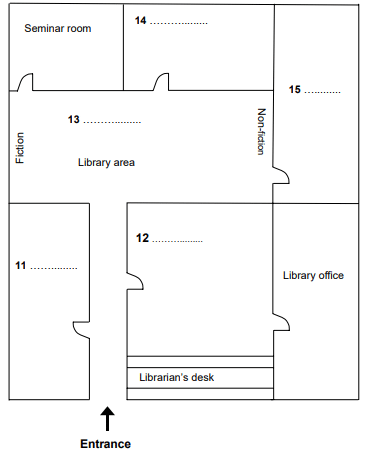
| A. | Art collection |
| B. | Children’s books |
| C. | Computers |
| D. | Local history collection |
| E. | Meeting room |
| F. | Multimedia |
| G. | Periodicals |
| H. | Reference books |
| I. | Tourist information |
Example 2:
The map has 8 labels. Choose the correct labels for each building.
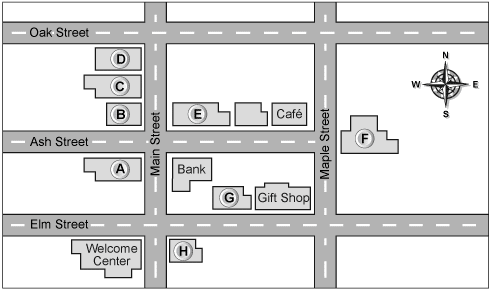
| A | B | C | D | E | F | G | H | |
| Quilt Shop | ||||||||
| Handicraft Museum | ||||||||
| School Shop |
d) Form, Note, Table, Flow Chart, Summary Completion
You’ll be presented with either an incomplete form, note, table, flow chart, or a summary based on the audio recording or parts of it. You need to complete them using the information from the audio recording.
Example 1:
Complete the note below.
Your answer for each should be no more than three words/numbers.
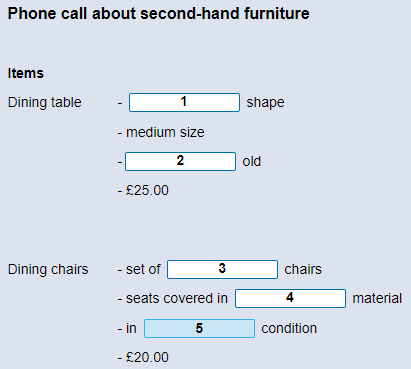
Example 2:
Complete the table below. Your answer for each should be no more than three words/numbers.
| Transport | Cash Fare | Card Fare |
| Bus | $4 | __________ |
| Train (peak) | _________ | $7 |
| Train (off-peak) | $6 | $5 |
| ________ ferry | $3 | $2 |
| Tourist ferry | $8 | __________ |
e) Sentence Completion
You’ll be presented with incomplete statements, and you need to complete them using the information from the audio recording. Usually, you have to complete the statements in not more than three words, but to be sure, you must confirm this with the given instructions.
Example:
Complete the sentences below.
Your answer for each should be no more than three words/numbers.
1. In the eighteenth century, the ___________ determined how most people made a living.
2. There were minerals on the ground which gave ___________ of the region.
3. Some potters worked in a few ___________ situated on the small hills of South Staffordshire.
f) Short Answer Questions
You’ll be presented with questions that you need to respond to. This type of question, like the sentence completion task, usually requires answers in no more than three words, but double-check the instructions to be sure.
Example 1:
Answer the questions below.
Your answer for each should be no more than three words/numbers.
1. How do the students do their practical sessions?
2. How often did Sue work in the hospital in the first semester?
3. How much full-time work did Sue do during the year?
Example 2:
Answer the questions below.
Your answer for each should be no more than three words/numbers.
1. What two attractions are most popular with tourists?
___________
____________
2. Name two changes that will take place in the venue after the winter season.
____________
____________
3. IELTS Academic Reading Section
The IELTS Academic Reading Test takes 60 minutes to complete, and there are three parts. There are three long texts that range from 500 to 900 words in length. There are 40 questions in total. The IELTS Academic Reading Test texts are factual, descriptive, and discursive excerpts from books, magazines, journals, and newspapers.
The IELTS Academic Reading Test appraises a variety of reading abilities such as reading for main ideas, reading for detail, skimming, understanding logical argument, and recognizing writers’ perspectives, attitudes, and intent.
Here are the different question types that will appear in the IELTS Academic Reading Test.
a) Multiple Choice
You’ll be presented a ‘stem,’ which could be an incomplete statement or a question. Three of four options follow the stem, but only one will be correct (the answer); the other three will appear correct but will be wrong in some way (the distractors).
Example:
Select the correct letter, A, B, C, or D.
1. What does the writer suggest to businesses, as mentioned in the first paragraph?
A. Eliminate pay schemes that are based on age.
B. Avoid paying based on piece rates.
C. Increase the pay for older employees.
D. Equip more senior employees with new skills.
2. ‘Bridge jobs,’ according to the writer,
A. attract middle-class people.
B. They are better paid than some full-time jobs.
C. Originated in Europe.
D. Appeal to specific groups of older employees.
b) Identifying Writer’s View
You’ll be presented with a series of statements. You need to analyze whether these statements agree with the writer’s viewpoints and recognize the writer’s point of view not just from what is directly stated but also from what is implied.
Example:
Does the information in the reading text accord with the following statements?
YES if it agrees with the writer’s point of view
NO if it contradicts the writer’s point of view
NOT GIVEN if it doesn’t say what the writer thinks about it
1. Watching TV before going to sleep is harmful.
2. There is a connection between computer use and mental health among teenagers.
3. Kids should take their eyes off an electronic screen before bedtime.
c) Matching Information
You’ll be presented a series of statements, and you need to identify the paragraphs where these statements are from.
Example:
The text has six paragraphs labeled A-F.
Which paragraphs contain the following information?
- Advantages and disadvantages of using public transport ________
- The writer’s suggestions on future problems ________
- Increasing numbers of motor vehicles ________
d) Matching Headings
You’ll be presented with a list of headings. You need to pick the most appropriate heading for each paragraph.
Example:
Which heading best sums up the main idea of paragraphs D, E, and F of the text.
Write the appropriate numbers I – VI on your answer sheet.
I. How the Julian calendar works
II. Advantages of following two calendars
III. Early adoption of the Gregorian calendar
IV. Development of the Gregorian calendar
V. Disadvantages of using the Julian calendar
VI. Reasons why some countries changed their calendars late
1. Paragraph D _________
2. Paragraph E _________
3. Paragraph F _________
e) Matching Features
You’ll be presented with a number of options with the relevant set of statements. You need to match the options given to the names or features based on the information in the reading text.
Example:
Match each item with the group that first invented them. Write the correct letter A, B, C, D, or E.
You may use any option more than once.
A. USA
B. Japan
C. France
E. Sweden
F. Germany
1. It was the biggest producer of films. __________
2. Its productions are mainly silent movies. __________
3. It made movies about other countries rather than its own. __________
f) Matching Sentence Endings
You’ll be presented with a list of incomplete sentences and possible sentence endings. You need to match them together based on the information in the reading text.
Example:
Complete each sentence with the correct ending. Write the correct letter A-F.
1. Passive smoking ________
2. Doctors believe that ________
3. Unlike a non-smoker, a smoker ________
A. Lung cancer is a disease that is less likely to strike.
B. It is one of the two leading causes of death that may be avoided.
C. It is more susceptible to the diseases caused by passive smoking.
D. Reduces the amount of blood that circulates throughout the body.
E. The government calls for tougher anti-smoking laws in public areas.
F.Active smokers are more likely to get a variety of malignancies.
g) Sentence Completion
You’ll be presented with a number of incomplete sentences. You need to complete the sentences using information from the reading text.
Example:
Fill in the gaps to complete the sentences below.
Use words taken from the reading text.
Your answer for each should be no more than three words/numbers.
1. A large number of smokers want cigarette companies to have ___________.
2. The most recent strategy to discuss the problems of smoking is ___________.
3. Packaging of cigarettes is seen as the ___________ in the cigarette industry.
h) Note, Table, Flow Chart, Summary Completion
You’ll be presented with either an incomplete form, note, table, flow chart, or a summary based on the reading text or parts of it. You need to complete them using the information from the reading text.
Example 1:
Complete the table below.
Your answer for each should be no more than three words/numbers.
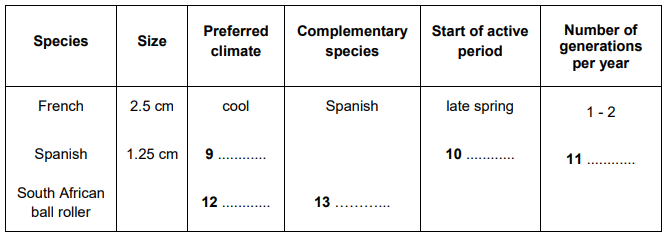
Example 2:
Complete the summary below.
Your answer for each should be no more than three words/numbers.
When putting together do-it-yourself items that have not been tested on a 1. ___________, consumers frequently claim that they get a 2. ___________ feeling. It is a must to abide by the critical procedures in circumstances where not doing so could jeopardize safety. It is crucial that 3. ___________ information isn’t overlooked and that no assumptions are made.
i) Diagram Label Completion
You’ll be presented with a diagram, and you need to label it. You might be given options, or you will have to select the answer from the reading text itself.
Example:
Label the diagram below.
Your answer for each should be no more than three words/numbers.
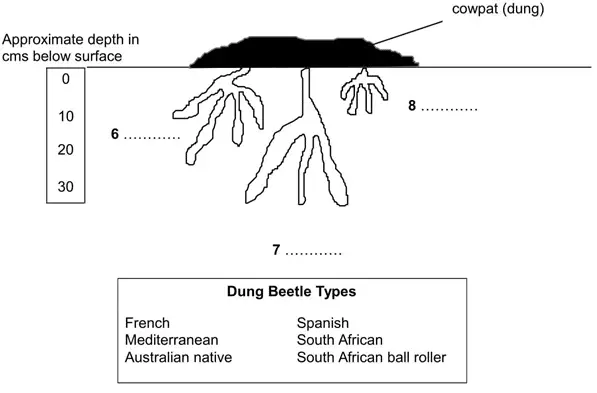
i) Short Answer Questions
You’ll be presented with a series of questions to answer. In general, your answers should be three words or less, but check the instructions to be sure.
Example:
Answer the sentences below using words from the reading text.
Your answer for each should be no more than three words/numbers.
- What disease affected most caisson workers?
- What problems did the workers encounter with the cables?
- What did the workers use to fill the caissons once they are deep enough?
4. IELTS Academic Writing
The IELTS Academic Writing Test takes 60 minutes to complete and has two tasks to be accomplished. The second task has more weight so you should spend more time on it.
a) Task 1
The first task requires you to explain a graph (bar, line, or pie graph), table, or diagram of how something works or how something is done. You need to have at least 150 words.
The IELTS Academic Writing Test Task 1 determines your capacity to choose and report the most important aspects, describe and compare facts, discover significance and trends in factual data, or describe a process.
Here are the different question types that will appear in the IELTS Academic Writing Test Task 1.
Bar, Line, and Pie Graph
You’ll be presented with either a bar, line, or pie graph. You need to describe and explain the data in the graph.
Example 1:
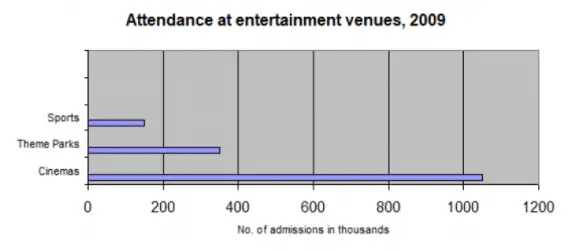
Example 2:
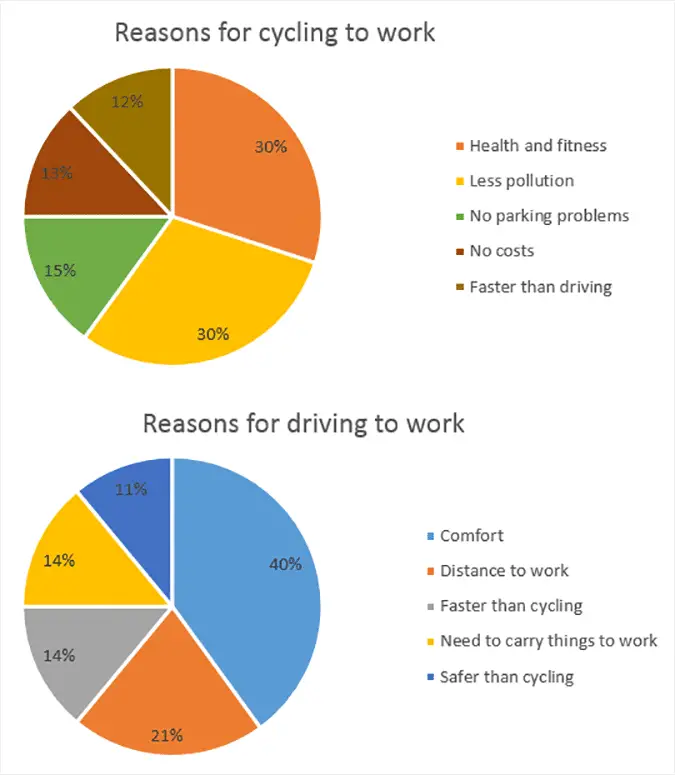
Table
You’ll be presented with one table of data. You need to describe and explain the data given in the table.
Example:
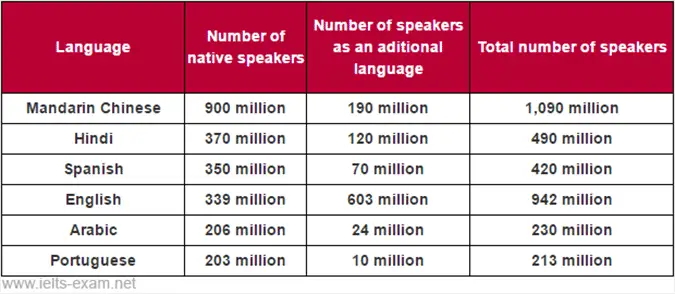
Diagram
You’ll be presented with a diagram of a process. You need to describe and explain the data given in the diagram.
Example:
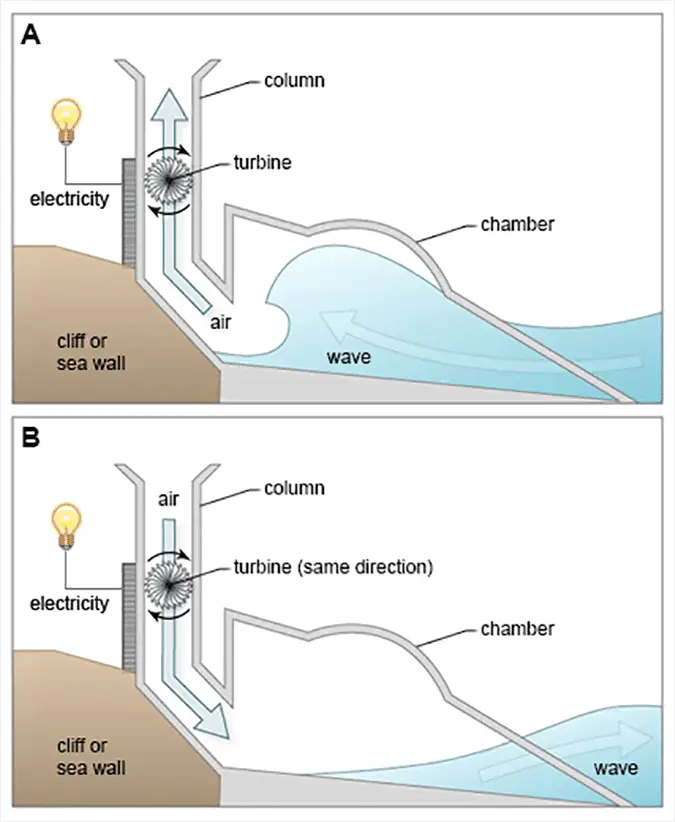
b) Task 2
The second task of the IELTS Academic Writing Test, on the other hand, requires you to write an essay based on your point of view or argument. You need to have at least 250 words in your essay.
The IELTS Academic Writing Test Task 2 assesses your ability to offer a coherent, relevant, well-structured argument, support concepts with evidence or examples, and use language correctly.
Example 1:
Argument/Problem:
Overpopulation is currently the world’s worst environmental problem.
Do you agree or disagree?
Write an Essay:
Cite reasons for your answer and include any relevant examples from your knowledge or experience.
Example 2:
Argument/Problem:
The number of students taking up science at school and in university is dramatically decreasing, and more and more students prefer to take up computer-based courses.
Is this good or bad?
Write an Essay:
Discuss and give your opinion on both views. Cite reasons for your answer and include any relevant examples from your knowledge or experience.
Additional FAQs on IELTS Academic Test
What is the Difference Between IELTS Academic and IELTS General Training?
The difference between the IELTS Academic and the IELTS General Training is the people it is designed for. The IELTS Academic Test is intended for those who want to pursue university studies and seek professional employment.
Moreover, the IELTS General Training is intended for those who plan to study or train below degree level. While the IELTS Academic Test evaluates your readiness to work in the academic and professional setting, the IELTS General Training test assesses whether you are ready to interact in a social setting.
Is IELTS Academic Hard?
Generally, the IELTS General Training Test is more challenging than the IELTS General Training Test.
However, it does not mean that it is that difficult. It is a standardized test designed to put your English skills to the test but achieving a band score of 8 to 9. It all comes down to how well you prepare and study for the test.
